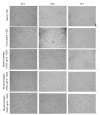Experimental study of a novel tumstatin on C6 brain glioma in vitro
- PMID: 28928823
- PMCID: PMC5588131
- DOI: 10.3892/ol.2017.6507
Experimental study of a novel tumstatin on C6 brain glioma in vitro
Abstract
To investigate the effect of a novel tumstatin on C6 brain glioma cells, the MTT method was used to detect C6 glioma cell proliferation activity at different time periods (12, 48 and 72 h). Cell cycle distribution and apoptosis rate were detected by flow cytometry, and the acridine orange/ethidium bromide staining method was used to detect apoptosis and mitochondrial membrane potential by fluorescence microscopy. Novel tumstatin had an evident inhibitory effect on C6 glioma cells, and the most notable impact emerged after 48 h. The following were observed under the fluorescence microscope: Characteristic morphological changes of cell apoptosis were typically observed in the novel tumstatin (2,000 µg/ml) group; mitochondrial membrane potential decreased significantly (P<0.05); the cells in the G0/G1 phase significantly increased (P<0.05); and the number of cells in the S phase was reduced. There was an increase in cell apoptosis rate in the novel tumstatin (2,000 µg/ml) group compared with the novel tumstatin (1,000 µg/ml) group and the Mock group, and the data were statistically significant (P<0.05). Novel tumstatin may reduce the mitochondrial membrane potential, inducing cell apoptosis, and thereby exerting antitumor activity.
Keywords: C6 glioma cell; cell apoptosis; flow cytometry; novel tumstatin.
Figures




References
-
- Zhao JX, Liu XQ, Dong BJ. Primary study of bevacizumab combined with temozolomide for recurrent glioma. Chin Clin Oncol. 2011;39:920–922.
LinkOut - more resources
Full Text Sources
Other Literature Sources
